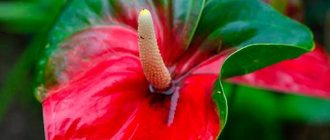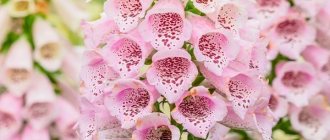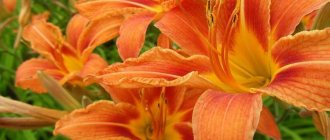Spathiphyllum or spathiphyllum (Spathiphyllum) from the Araceae family is a close relative of Anthurium and Alocasia and is a magnificent flowering plant native to the hot and humid tropical forests of Central and South America and some Pacific islands (Guiana, Moluccas, Philippines).
In our homes, these beautiful plants not only decorate the interior, but also create a healthy atmosphere.
According to NASA research, the tropical perennial is included in the list of 17 filter plants because it has the ability to purify the air from harmful chemical compounds and filters the air from fungal spores, which is important for people prone to allergies.
To perform the cleansing function, only one plant per 20-25 m2 is required.
Characteristic
The indoor lily with wide leaves is a potted plant with a gorgeous flower crowned by a long, dense stem. The similarity with the classic lily of the Liliaceae genus is based on the arrangement of the petals and the structure of the flower.
Eucharis belongs to the genus Amaryllis bulbous plants. Distribution throughout the world began in the second half of the 19th century, when the bulbs were brought from Colombia and the Amazon by botanical explorers. Lily began to be grown as a houseplant, requiring some care.
Description of the appearance of the plant:
- Bulb. The diameter of one bulb reaches 6 cm. Bulbs are often collected in groups of 2-5 pieces.
- Leaves. Large oval leaves up to 55 cm long and up to 20 cm wide are attached to the bulbs using long thick cuttings. The leaves are glossy and smooth, painted in a rich dark green color. One plant can produce 2 or 4 leaves.
- Flower. The umbrella-shaped inflorescence contains 3-10 flowers with special curling petals. Large flowers form seeds after flowering. The fruit is a leathery three-membered capsule.
The photo shows indoor lily flowers.
There are 20 species of indoor lily with wide leaves, but indoor cultivation involves the cultivation of 4 common species.
| Kinds | Description | Peculiarities |
| Large-flowered | A classic look that has large flowers with corollas reaching 12 cm in diameter. Large dark green leaves are pointed at the end point. Flower arrows extend up to 80 cm. | Representatives of the species are characterized by the presence of a persistent aroma. Flowering occurs in December, August and May. |
| White | The inflorescence is formed by 5-10 white buds, the diameter of each of them reaches 7 cm. The leaf plates are narrowed on both sides. | The species blooms at the beginning of autumn and end of spring. |
| Sandera | The species that most closely resembles the classic lily. The diameter of the flower corolla reaches 10 cm. The foliage differs from other species in its change in shade; over time it acquires a rich light green hue. | The flowering period occurs in February and September. |
| Amazonia | Representatives of the species are characterized by the presence of oval leaves without narrowing or pointed. The flowers are distinguished by smooth lines and the formation of elongated petals. | With proper care it can bloom up to 4 times annually. |
Between representatives of the species, hybrid flowers are often formed, which form separate groups.
The indoor lily is known for developing into a rich mass of foliage. Without the ability to grow foliage, the flower dies or completely stops growing. To provide the plant with this opportunity, it is necessary to create a comfortable environment.
Eucharis needs to follow some rules:
- providing lighting without direct sunlight;
- selection of nutritious soil rich in organic matter;
- introducing the necessary subcrusts to maintain strength at each growing season;
- systematic watering.
Varieties and types of spathiphyllum with photos
The genus includes about 40 species, but only 2-3 of them have become widespread as indoor plants. The species and their varieties differ from each other mainly in the shade of flowers, foliage and height, which varies from 30 cm to 1.8 m.
Some of the most popular varieties in indoor gardening come from the species Spathiphyllum wallisii, which first came to Europe in 1824 after being found in the Colombian jungle by the German collector Gustav Wallis.
Spathiphyllum wallisii
An equally popular species is Spathiphyllum floribundum.
Lovely spathiphyllum (Spathiphyllum blandum) is distinguished by the green or light green-lemon color of the spathe around the inflorescence, which is why it is also called “green spathiphyllum”. Flowering is not as abundant as other species.
Spathiphyllum blandum
Description of spathiphyllum varieties:
Spathiphyllum "Sensation" is a favorite of gardeners, the largest variety, reaching a height of 1.5 m. The huge, ribbed leaves of the variety give the room a tropical atmosphere. Over time it grows in width.
"Sensation"
Spathiphyllum "Chopin" is a low cultivar with numerous light green leaves, straight or slightly curved. The flowers are white, cream or green.
"Chopin"
Spathiphyllum "Silver Cupido" from the Cupido varietal series. Its shiny leaves have a silvery variegated hue, which is why buyers often wonder, “Is this plant real?”
"Silver Cupido"
The new variety of spathiphyllum “Domino” has white inflorescences and spectacular variegated foliage; its variegated form is popular on sale.
Spasyphyllum "Sweet Lauretta" is a majestic variety of Dutch breeders with large leaves and inflorescences.
Spathiphyllum "Lauretta"
Variegated variety of spathiphyllum "Gemini". Dark green foliage has white stripes and spots.
"Gemini"
Spathiphyllum 'Vivaldi' is medium sized with many beautiful glossy, dark green leaves and large white spathes that can last for almost 2 months.
"Vivaldi"
A delightful variegated variety - spathiphyllum "Picasso" with a striking, creamy-green foliage color.
"Picasso"
Spathiphyllum "Alana" is a 40 cm high cultivar with light green, delicate foliage.
Spathiphyllum "New Van" (New One) with numerous, long, spear-shaped and variegated leaves on short petioles.
"New van"
Miniature varieties about 30 cm tall are beautifully presented, for example, an extremely compact variation of the Cupido series - “Cupid's Pearl” or a smaller copy of the “New Van” - “Angel Baby”.
Their opposite is the magnificent hybrid "Mauna Loa", which grows up to 1 meter, or the spectacular variegated and broad-leaved variety of spathiphyllum "Diamond Variegata".
The range of sizes allows you to choose a suitable specimen for growing in different rooms.
Preparation of planting material and propagation
To propagate indoor lilies, one of two methods can be used:
- Seminal. A method when seeds purchased from intermediaries are planted in prepared soil and grown in compliance with the rules of care. The method is designed to ensure that the first flowers can appear only 5 years after planting. The disadvantage of the method is the inability to predict the result.
- Bulbous. This is the most common method. Planting bulbs and propagating the mother bulb in divisions allows you to obtain an adult plant with flowers in the second year after planting. The division of bulbs is associated with taking into account the characteristics of the root system.
When choosing planting material for cultivation, it is recommended to pay attention to the appearance of the bulb:
- You should not choose bulbs whose diameter is less than 3 cm;
- each bulb should be elastic, free from spots and growths;
- after forcing, the roots sent out by the bulb look weak, but this does not affect the growth of the lily after planting.
Planting material must be properly prepared for planting. If the purchased bulbs are too dry, they are placed in water for 2 hours, then removed for further storage. Before planting, the bulbs are stored in the refrigerator at a temperature of 0 to -2°C.
The bulbs are placed in a plastic bag filled with peat or sawdust. Drainage holes must be made in the bag. Before planting, the bulbs are disinfected in a manganese solution, and damaged scales are removed from the surface.
How to ensure a dormant period for lilies during the winter season?
Outdoor and indoor plants need rest. During the moment of “hibernation” they restore the strength spent during growth and flowering. Temporary dormancy ensures the lily will bloom again in the coming season.
The plant itself tells a person when it needs to be prepared for the dormant period. The stem turns yellow and the flowers wither and fall off. Over time, the stem and leaves dry out. This indicates that the lily no longer needs watering. The above-ground part of the plant transfers all the accumulated substances to the bulb, so the flower is dug up and placed in a plastic bag. The place where the bulb is kept should be cool. The bag is often filled with sawdust for better storage.
Some gardeners leave the bulb in the ground and change the soil to new soil in the spring.
The indoor lily is one of the most beloved plants. Often decorates window sills, balconies or loggias of residential premises and offices. The plant is popular due to its large, richly colored flowers. The difference with the street counterpart is the size of the flower. But beauty depends on the care of a person.
Preparing the soil and planting site
Indoor lilies, which have wide leaves, grow on nutritious, loose soil with good drainage. The acidity of the soil is not particularly important for lilies. The normal option is to select soil with an acidity ranging from 5 to 7 PH.
Main soil characteristics:
- the basic element is turf, leaf soil or black soil;
- presence of nutrients: compost or humus;
- sand, vermiculite or expanded clay are chosen as a leavening agent;
- charcoal is added as the main element of disinfection; it helps reduce the risk of rot developing on the bulbous roots.
You can prepare the soil yourself using the traditional formula:
- leaf soil or turf - 3 parts;
- peat or compost – 1 part;
- drainage – 1 part.
All components of the mixture are calcined in the oven before cooking to avoid the development of rot or the proliferation of microorganisms.
For the plant, it is necessary to choose the right container and location. Lilies are suitable for stable, low pots in which the root system should completely entwine the earthen ball. The pots are placed on window sills or stands, where the plant will be constantly lit, but protected from direct sunlight, which can burn the leaf plate.
Landing algorithm
Bulbs are grounded in spring or fall. These times of year are traditionally considered the right time for planting or transplanting as they begin a new cycle of plant growth.
Planting involves following step-by-step instructions:
- A soil layer is poured into the pot on top of the drainage layer.
- The onion is placed in the center of the container. The voids between the bulb and the walls of the pot are filled with soil and lightly patted down.
- The soil surface is watered.
Transplantation of an adult plant is carried out according to the same scheme, but it is taken into account that the leaves may disintegrate after the bulbs are freed from the soil. To prevent this from happening, the leaves are tied in advance with strong twine. Adult plants are transplanted into a larger pot using the transshipment method. This means that the bulbs are moved to a new container with an old lump of earth.
Home care
The indoor lily with wide leaves is not demanding in terms of maintenance conditions, but violation of traditional care methods can lead to stunted growth and lack of flowering. Bud formation is the goal of cultivation, so all efforts of flower growers are aimed at creating comfortable conditions for this.
Spraying, watering
Eucharis loves moist air. Spraying is carried out during the period of growth of green mass, but is completely stopped when buds appear. Moisture on the petals can cause rot and wet spots to form.
Watering should be regular and moderate. Overmoistening the soil will cause the bulbs to rot, so it is best to water only when the soil becomes dry on the upper surface area. The basic rule of watering excludes adding water in the center of the container, to the base of the stems.
Start watering the lily along the edge of the pot, using warm, settled water. The water that appears on the pan must be completely removed after watering. When the dormant period begins, the number of waterings is reduced by 2 times.
Top dressing
For abundant annual flowering of indoor lilies, systematic feeding is necessary.
They are carried out in accordance with the stage of plant growth:
- during the period of bud formation, mineral complexes with a high content of potassium and phosphorus are added;
- during the growth of green mass, nitrogen-containing fertilizers are added;
- To prevent the risk of rot and support the plant before active growth, add wood ash to the soil.
Transfer
For indoor lilies, replanting is recommended once every 3-4 years with complete renewal of the soil. Eucharis does not like too frequent replanting, but it suffers if the pot size becomes too small.
In addition, transplantation solves division problems. During transplantation, the mother plant can be divided into 2 or 3 parts. Each part is transplanted into a new container and then grown in accordance with the recommended rules.
Trimming, tying
When plants enter a dormant period, many novice gardeners make a grave mistake. They remove yellowed leaves from the pot that have lost their attractiveness. Leaves should not be removed after flowering.
Nutrients are supplied to the bulbs from fading leaf plates; they participate in the laying and development of future children. Pruning is carried out only after the flower has undergone a dormant period. The end of the period is indicated by the appearance of young shoots. Faded buds usually fall off on their own.
Heavy, dense leaves can cause the pot to tip over. To prevent loss of stability, gardeners recommend tying up the leaves or placing a support, and when a favorable period comes, planting the plants using the bulb division method.
Temperature and humidity
Despite the fact that indoor lilies love moist air, it is not recommended to specifically moisten it. In winter, you can place additional containers of water next to the pot to reduce air dryness.
The optimal temperature regime for lilies is + 20-22°C.
During the dormant period, the temperature regime is artificially reduced by moving the pot with the plant to a cooler room, but the temperature should not be reduced by more than 10-12°C. When the temperature drops below + 10 + 8°C, the lily begins to gradually stop developing.
Description of spathiphyllum
The plant has green glossy leaves with visible veins, growing on long petioles. The period of active growth of green mass is from March to September.
Flowering in nature often occurs twice a year, at home usually once in the spring, and if favorable conditions are created for spathiphyllum, flowering will continue for more than a month.
At the tops of tall peduncles, aroid-type single flowers appear, which consist of one or two bracts in the form of a modified leaf-veil located around the inflorescence-cob.
Blooming spathiphyllum floribunda
The color of the bedspread is initially white with exposed green veins, and then becomes greenish over time.
Is Spathiphyllum poisonous to cats and other pets? The plant is not poisonous, but contains insoluble calcium oxalates, which cause a strong burning sensation in the mouth, nausea and, less commonly, vomiting.
Variety "Diamond Variegata"
In Western countries, the plant is called the “peace lily”, drawing an analogy between the shape and color of the bract and the white flag of truce. If people believe that anthurium is a male flower, then the popular name for spathiphyllum is the flower of female happiness.
According to signs and superstitions, spathiphyllum has many magical properties.
Indoor begonia - care, varieties, propagation
According to one of the Greek legends, the goddess of love Astarte breathed into the flower a piece of happiness that filled her on her wedding day. Since then, it is believed that the plant can give happiness to any woman who believes in its power.
It is believed that spathiphyllum restores harmony and trust between spouses, prevents conflicts, and connects generations.
Popular beliefs also recommend growing female and male happiness in the same pot to ensure family happiness. And to improve your financial situation, it is advised to put a coin under a flowerpot.
Possible diseases and pests, ways to get rid of them
The danger for indoor lilies is excessive waterlogging. It can create comfortable conditions for the development of root rot. This fungal disease often affects indoor lilies.
Signs of root rot:
- yellowing of leaves;
- lethargy;
- growth slowdown;
- spots form on the tips of the leaves.
Root rot prevents the growth of green mass and bud formation. Upon careful examination of the bulb, you can see the affected areas covered with spots of mold.
Treatment includes pruning leaves that are affected by rot, as well as completely treating the flower with copper-containing products. The best option would be to choose drugs such as copper sulfate, Fundazol or Topsin-M.
Red burn or stagonospora affects eucharis where temperature fluctuations often occur. The plant gets a red burn when it is overcooled or overwatered.
Signs of a red burn:
- the appearance of red spots on the leaves and buds;
- wilting of leaves and peduncles;
- curvature of buds.
The result of the disease is rotting of the bulbs and death of the plant. Timely detection of the disease allows you to cure the plant and bring it back to life. The bulb is freed from the soil, the damaged areas are inspected, and the damaged areas are cut off until healthy tissue appears.
The affected areas are treated with brilliant green or crushed activated carbon. Rotten bulbs are left on a napkin until dry for 2-3 days. Then a new substrate is selected and the planting material is replanted. To prevent the development of red burn, it is necessary to follow the rules of care, as well as treat planting material with targeted fungicides.
House lilies with wide leaves are rarely infested by pests, but if the rules of care are not followed, the following parasites may appear on the flower:
- Spider mite. Insects appear on indoor lilies when the air is dry and at high temperatures. The appearance of a spider mite can be detected by the presence of a thin cobweb on the inside of the leaf blades. The leaves must be treated with a solution of laundry soap. In case of massive damage, the plant is treated with acaricidal preparations.
- Sciarides or fungus gnats. Constant waterlogging of the soil provokes the appearance of black midges. Mosquitoes lay eggs on the bulbs, the emerging larvae feed on the juice and tissues of the bulbs, leading to complete oppression of the plant. The flower against fungus gnats is additionally treated with a solution of laundry soap or chemicals.
- Scaleworms. These are pests that develop on bulb scales. Their activity leads to curvature of leaves and peduncles and negatively affects sap flow. Scale insects are destroyed with insecticides. Treatment of soil and plants against scale insects should be done regularly.
Peculiarities
Growing indoor lilies involves taking into account nuances. The main advantage of choosing an indoor lily is its decorative properties.
In addition, there are several advantages associated with the quality characteristics of the flower:
- undemanding conditions of care;
- magnificent appearance throughout the growing season;
- presence of a persistent pleasant odor;
- the presence of lush green mass;
- air ozonation;
- creating a special indoor microclimate;
- destruction of some small insects.
The following features are considered to be the disadvantages of growing:
- Amazon lily is a poisonous alkaloid, it can cause minor harm to the skin with prolonged contact, therefore all procedures associated with transplanting and processing the plant are recommended to be carried out with rubber gloves;
- Eucharis should not be placed next to plants that will compete with it, since the indoor lily can suppress the energy of even the most powerful plant.
Even a novice gardener can cope with growing indoor lilies. The plant does not show any special care requirements. When creating comfortable conditions, it can delight owners with luxurious wide dark green leaves and magnificent buds of different shades.
Homeland of the plant
The magnificent exotic species lives in the wild in the subtropics and tropics of South America and Asia . The areas of Colombia, Malaysia, the Amazon basin and the Solomon Islands can boast of species diversity.
Favorite places are moist equatorial forests, coastal areas, river valleys, lakes and reservoirs. In their natural environment, plants live as terrestrial “inhabitants”; some species with creeping roots are epiphytes and heliepiphytes (they cling to supports such as trees, stumps, stones).











